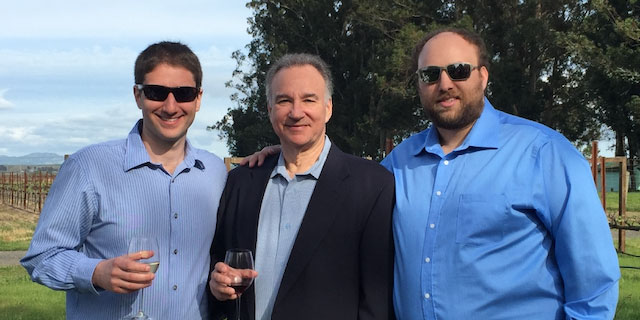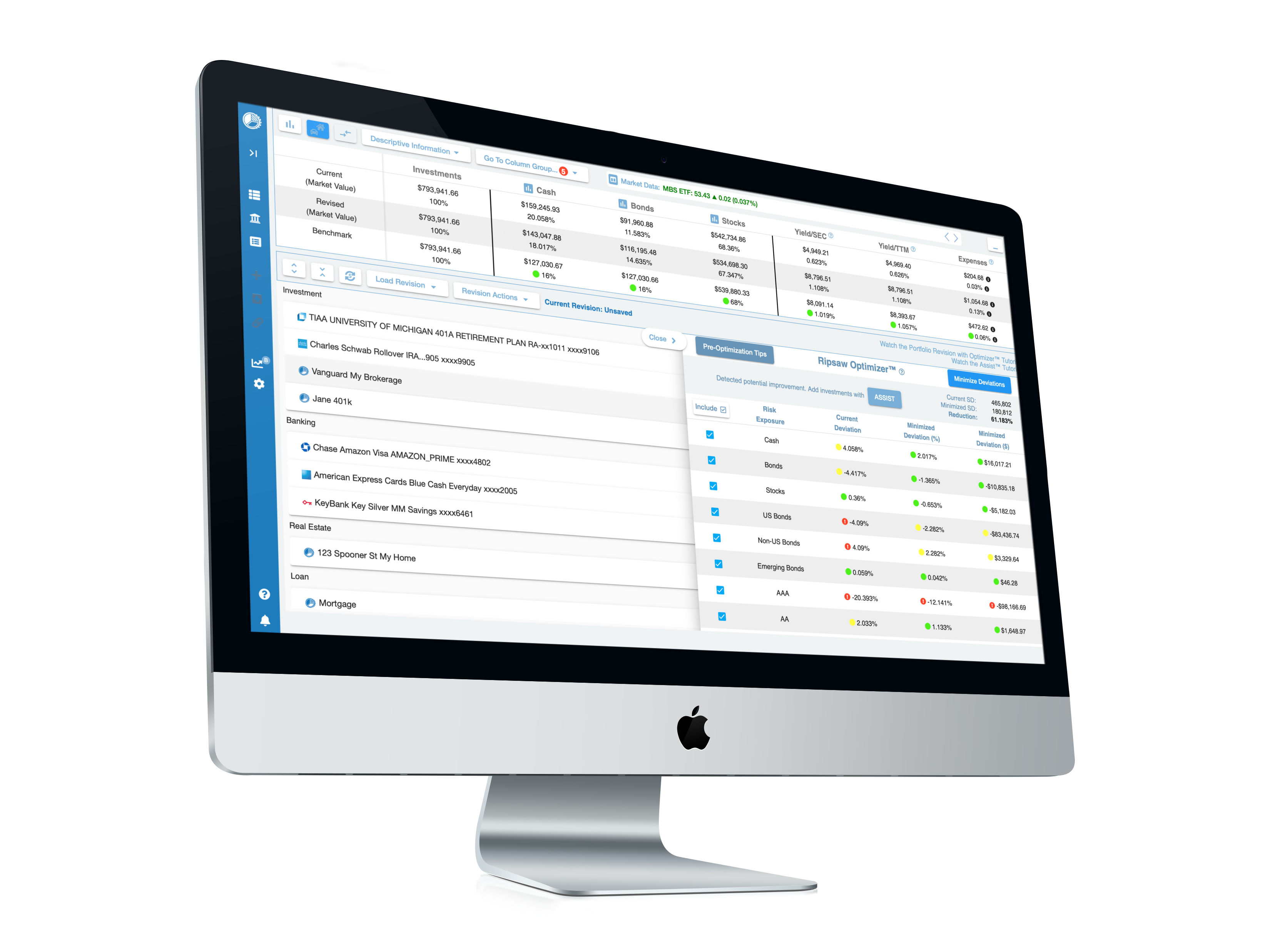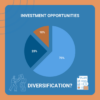After 25 years of teaching investment management, immersed in research, publishing and consulting as a Professor of Finance at some of the finest business schools and 15 years as Director of Research, Co-Director of the Investment Management Group and Principal of a sophisticated institutional investment management firm, Stanley J. Kon, PhD moved to the Colorado mountains. Skiing, hiking, the spectacular views and continuing as Editor of the Journal of Fixed Income seemed like the perfect plan to wind down and enjoy the grandchildren. Then his three 30-something married children asked him to recommend investments in their retirement accounts.
About Ripsaw®
Our Story and Team
The challenge: Implement a self-sufficient portfolio management system
A NEW SPREADSHEET SYSTEM
In order to better understand the complexity of what his children were facing, Stanley created a spreadsheet for each family of all their real and financial assets and liabilities, in order to focus on managing net worth. Each asset and liability had a long row of their respective risk dimensions. Then the investment weighted average of each risk dimension represented portfolio level risk characteristics in a dashboard. Each family had a home and mortgage, multiple 401K and IRA plans from dual incomes and past employment plus a variety of brokerage, savings and checking accounts. Many of the funds among their accounts had overlapping risk dimensions, insufficient portfolio level diversification, active management risk and excessively high costs that were detrimental to wealth accumulation, especially in a low interest rate environment. In each case, a strategy was developed that improved portfolio performance substantially by lowering aggregate cost, improving after-tax income, and obtaining a more suitable risk-return profile. The process became so useful that he began doing it for extended family and friends.
THE FUTURE CHALLENGE
The problem remaining was that they all still needed him. Stanley wanted his children to be self-sufficient, especially after he was gone. His children have demanding careers that required an efficient wealth management system with a limited time commitment. They would need some portfolio management concepts that he provided in the book Do-It-Yourself Wealth Management.

The working concept and birth of Ripsaw®
Implementation of these concepts is more complex. Spreadsheets are too cumbersome, require too much manual data input and have limited capacity for automation. Stanley knew that the ability to access accounts electronically was feasible. What was not clear to him is how to electronically access market data and detailed risk profile information on individual securities, mutual funds and ETFs to combine with account information upon which to build a user-friendly interface with underlying analytics for his view of a disciplined wealth management decision-making process.
AN AUTOMATED SOLUTION
Fortunately, Stanley has two sons, David and Joshua, that are technology and data experts with complementary skill sets. They said it could be done! Thus Ripsaw® was born, the name referring to their favorite black diamond ski run. An apt analogy to the challenges of navigating one’s financial landscape. Together, they formed Ripsaw LLC to develop Ripsaw® Wealth Tools. The result is a low fixed-cost subscription service platform that is sufficiently automated for the do-it-yourself (DIY) wealth manager to focus on achieving their investment objectives through a disciplined approach to portfolio construction, monitoring and revision decisions.

Our Leadership Team
The Ripsaw® team has vast combined experience in Finance, Economics, Data, Analytics, Product, Software, and Technology and a shared vision on making Wealth Management more accessible to all.

David J. Kon co-founded and now serves as the CEO of Ripsaw LLC. He has a wide range of executive experience in data, finance, and technology including serving as the Chief Data Officer at NISA Investment Advisors, a $450bn pension manager. David has built and lead highly functioning teams throughout his career that deliver above and beyond solving the hard and complex problems. He has always focused on improving the productivity and effectiveness of users through data and technology solutions.
Prior to that David worked in Collaboration Technologies at Vail Resorts, Inc. Before that, he worked in Data and Technology at Smith Breeden Associates as a Vice President. He also has extensive consulting experience in various industries and disciplines. Prior to that he was a technology risk consultant at Protiviti, Inc.
BS in Business Administration with an emphasis in Information Systems from the University of Colorado, Leeds School of Business.

Stanley J. Kon is Chairman of Ripsaw LLC where he oversees research, education, and product development. He also is the editor of the Journal of Fixed Income.
Dr. Kon has written extensively in the areas of investment management, performance measurement, asset pricing, statistical models of stock returns and mortgage-backed securities. He has published articles in the Journal of Financial Economics, Journal of Finance, Journal of Business, Journal of Empirical Finance, Journal of Fixed Income and Financial Analysts Journal.
He served as the J. B. Fuqua Visiting Professor of Finance at Duke University’s Fuqua School of Business where he taught courses in fixed income securities and risk management. He was also a Visiting Professor at New York University’s Stern School of Business where he received the Executive MBA outstanding teacher award.
Prior to that, Stanley was a principal, executive vice-president, director of research and co-director of the investment management group at Smith Breeden Associates, Inc., an institutional investment management company.
Prior to that, he was a Professor of Finance at the University of Michigan from 1982-1997. Prior to 1982, Professor Kon served on the faculties of New York University, the University of Chicago and the University of Wisconsin at Madison.
Dr. Kon also founded Modern Portfolio Strategies Inc. in 1985. The premiere product the MPS OPTIMIZER™ brought the most sophisticated portfolio selection techniques to computer software at the time. The MPS OPTIMIZER™ was used by investment management professionals and in business school classrooms across the country.
Dr. Kon has also served on several bank and holding company boards and as a consultant to government, business and financial institutions.
Dr. Kon received his BS in Chemical Engineering from the Lowell Technological Institute, his MBA in Finance and Economics from St. John’s University and his PhD in Finance from the State University of New York at Buffalo.

As CTO Joshua P. Kon oversees software design and engineering as well as technology infrastructure. He has extensive software engineering experience in and out of financial services. Prior to Co-Founding Ripsaw® Joshua served in software development roles at Flatirons Solutions where he pioneered work on microservice architectures; Credit Suisse where he was responsible for a system that recorded billion-dollar transactions; and PRI Investments where he led the development of their accounting reporting tooling.
BS in Computer Science with a minor in Mathematics from the University of North Carolina at Chapel Hill where studies included algorithms, artificial intelligence, economics, enterprise architecture, and advanced computer programming.

Jules Kramer has ten-plus years of expertise driving product, brand, and customer-led growth in complex industries, including defense, raw materials, tourism, education, and hospitality. As CMO, Jules brings this startup experience leading all marketing strategy and customer efforts at Ripsaw.
Most recently, Jules served as VP of Customer at Biofire, a Founders Fund-backed startup. At Biofire, he designed the national go-to-market strategy and built and managed marketing and content teams to launch the world’s first biometrically enabled handgun for home defense.
Before Biofire, Jules was Director of Policy at Glowlit, a machine learning startup creating price transparency in global raw materials. At Glowlit, Jules facilitated entrance into new markets, built and ran B2B and B2C marketing campaigns, and executed product feature developments based on regulatory and customer requirements.


